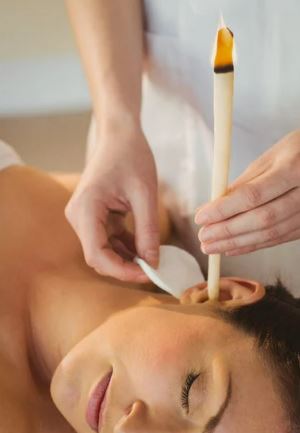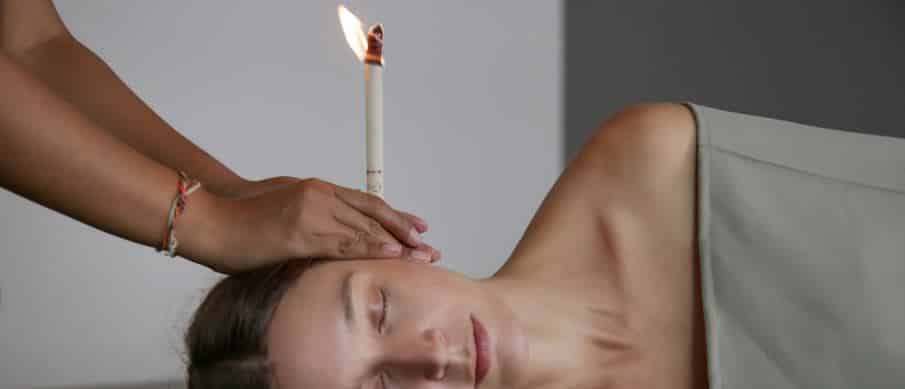Ear candling, a popular alternative medicine therapy believed to remove earwax, has garnered attention and raised doubts among medical professionals. This practice involves inserting a cone-shaped device made of linen or cotton soaked in wax or paraffin into the ear canal, which is then lit on fire.
Advocates claim that the burning candle creates a vacuum effect, drawing out earwax and impurities from the inner ear and other connected areas. However, medical experts remain skeptical about its efficacy and caution against its use.
History of Ear Candling
The origins and history of ear candling remain ambiguous. Various cultures, such as China, Egypt, the pre-Columbian Americas, Tibet, and the Hopi Indian tribe, have been linked to the practice, but no definitive origin has been established. Interestingly, the Hopi Tribal Council has explicitly stated that the Hopi people do not endorse or engage in ear candling. This adds to the mystery surrounding its true origins.
The procedure itself involves placing the candle in the ear canal while the person lies on their side. As the candle burns down, proponents claim that it draws out earwax and impurities. However, critics argue that the residue found inside the candle after the procedure is more likely a result of the burning process itself rather than actual earwax. Medical professionals question the effectiveness of this method and highlight potential risks associated with burns, ear canal injury, or blockage caused by candle residue.
Despite its popularity, medical experts, including otolaryngologists, family practitioners, and audiologists, generally view ear candling with skepticism. The consensus among professionals is that it is an ineffective method for earwax removal and may pose potential hazards.
Medical professionals express skepticism about the effectiveness and safety of ear candling as a method for earwax removal. Lack of scientific evidence and potential risks associated with the procedure have led experts to discourage its use.
Ear Candling Procedure: How is it Supposed to Work?
 Most ear candles sold in the United States are manufactured here or in Canada and retail for between $2 and $10. They can be made of linen or cotton (often unbleached, as practitioners claim that chlorine is bad for the ears) soaked in wax or paraffin and allowed to harden.
Most ear candles sold in the United States are manufactured here or in Canada and retail for between $2 and $10. They can be made of linen or cotton (often unbleached, as practitioners claim that chlorine is bad for the ears) soaked in wax or paraffin and allowed to harden.
Ironically, one manufacturer uses only pure beeswax, claiming that paraffin is carcinogenic. Some candles are colored, which is controversial in ear-candling circles, though the color of pure beeswax varies. Home varieties include wax-soaked newspaper and cones of pottery into which herbal smoke is blown.
Some waxes contain herbs or other substances, including sage, chamomile, rose, rosemary, burdock root, osha root, periwinkle, jojoba, quassia bark, yucca root, or honey.
Probably to avoid difficulty with the FDA, one company offers candles, plate guards, a 73-page manual, a 30-minute videotape, flame-retardant cloths, ear oil, and an otoscope. Its wholesale flyer states that its candles are “for entertainment only” and that its kits “supply you with everything you need for a safe and effective session of entertainment.”
The ear candling procedure (Click for video of the procedure) itself involves putting a hollow cone-shaped device or “candle,” typically made of linen or cotton soaked in wax or paraffin, in the ear canal, and lighting it on fire. The person undergoing the procedure lies on his or her side. A paper plate or other collection device is placed above the ear, and the candle is inserted through a hole in the plate into the ear canal. The candle is lit, and trimmed as it burns down. After the candle burns down and is removed from the ear, a cotton swab is used to clean visible wax from the ear, and oil is sometimes applied as a finishing touch.
The process usually ends with a sort of “earwax looking substance inside the candle. The problem is that this material is likely a result of the process of burning the candle and not earwax.
What About the FDA?
The FDA has prohibited ear candle manufacturers or practitioners from advertising that ear cleaning candles can cure ear aches, sinus infections, tinnitus, headaches, vertigo or other health problems. In 2010 the FDA notified consumers and healthcare providers of its warning not to use ear candles as they can cause serious injuries, even when used according to the manufacturer’s directions.
Their postings cite concerns about the advertised claims by alternative medicine and ear candle manufacturers that a burning ear candle draws ear wax, “impurities” or “toxins” out of the ear canal. They also cite concerns about other claims for ear candles that include relief from sinus and ear infections, headache and earache, as well as improved hearing, “blood purification,” improvements in brain function, and cure cancer.
While the FDA has received reports of burns, perforated eardrums and blockage of the ear canal that required outpatient surgery from the use of ear candles, they have found no valid scientific evidence to support the safety or effectiveness of these devices for any medical claims or benefits.
To make matters even worse, some ear candles are being advertised for use with children. According to the FDA warning, children of any age, including babies, are likely at increased risk for injuries and complications if they are exposed to ear candles. Small children and infants may move during the use of the device, increasing the likelihood of wax burns and ear candle wax plugging up the ear canal. Also, their smaller ear canal size may make children more susceptible than adults to injuries.

What Do Professionals & Researchers Think?
As one might imagine, professionals are totally skeptical about this procedure. There are a few research studies on this topic. One published in Laryngoscope (Seely et al, 1996) denies that any vacuum effect takes place as a result of lighting an ear wax candle, and that ear candling is more likely to result in wax deposits dripping into the ear.
In their study, tympanometric measurements in an ear canal model demonstrated that ear candles do not produce negative pressure. Their limited clinical trial (eight ears) showed no removal of cerumen from the external auditory canal. Candle wax was actually deposited in some of the subjects.
A survey of 122 otolaryngologists identified 21 ear injuries resulting from ear candle use. Their conclusion was that ear candles have no benefit in the management of cerumen and may result in serious injury. Ernst (2004) in an article from the UK indicates ear candling as a “triumph of ignorance over science.”
 Robert M. Traynor, Ed.D., is a hearing industry consultant, trainer, professor, conference speaker, practice manager and author. He has decades of experience teaching courses and training clinicians within the field of audiology with specific emphasis in hearing and tinnitus rehabilitation. He serves as Adjunct Faculty in Audiology at the University of Florida, University of Northern Colorado, University of Colorado and The University of Arkansas for Medical Sciences.
Robert M. Traynor, Ed.D., is a hearing industry consultant, trainer, professor, conference speaker, practice manager and author. He has decades of experience teaching courses and training clinicians within the field of audiology with specific emphasis in hearing and tinnitus rehabilitation. He serves as Adjunct Faculty in Audiology at the University of Florida, University of Northern Colorado, University of Colorado and The University of Arkansas for Medical Sciences.
**this piece has been updated for clarity. It originally published on July 23, 2013








Bob,
Thank you for a very comprehensive and persuasive post explaining why ear candling is a really terrible idea!